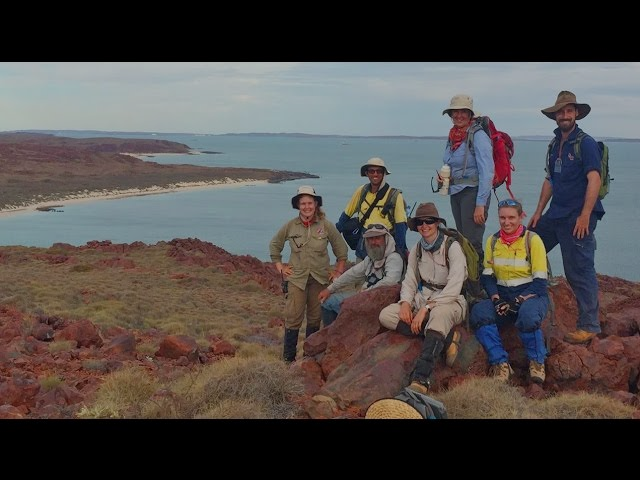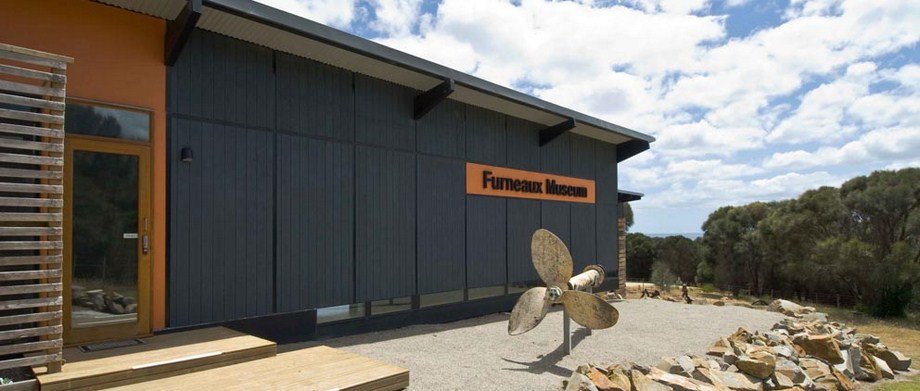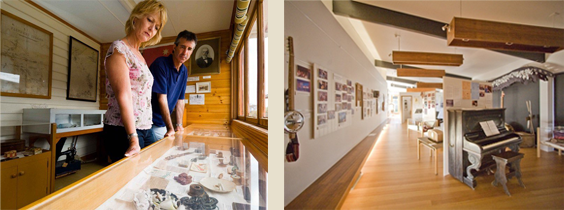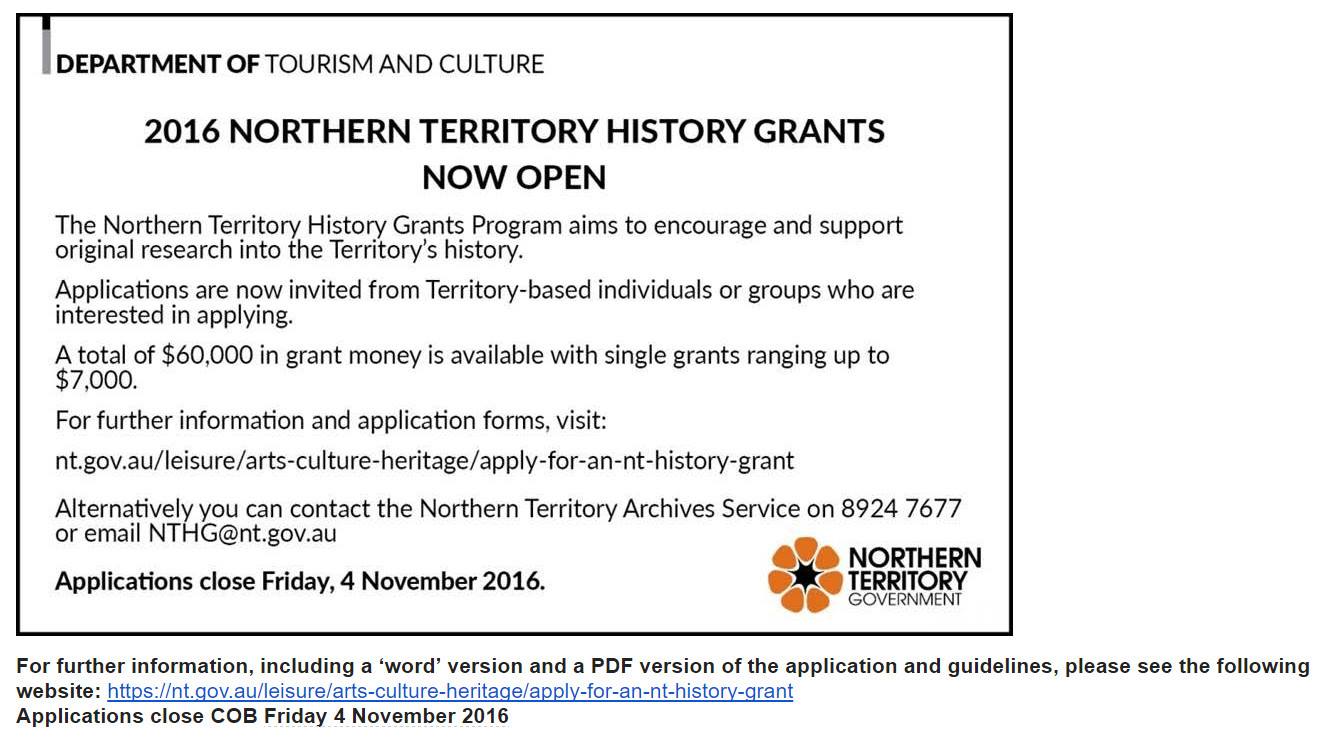|
FAHS 2016 AGM and October Meeting, held at RHSV
|
|
|
Delegates to the FAHS from Tasmania, NT, SA,
NSW, ACT, QLD, WA and Victoria with staff of FAHS met for the 2016 AGM
at the Royal Historical Society of Victoria.
L to R: Associate Professor Ian Jack
(RAHS, Vice President FAHS); Dr Ruth Kerr (RHSQ, Immediate Past
President, FAHS); Julia Ryan (CDHS); Catherine Pearce (THRA); Esther
Davies (CDHS, Vice President, FAHS); Nick Drew (RWAHS, Hon. Treasurer, FAHS);
Emerita Professor Kay Saunders (RHSQ); Hon Bob Nicholson (RWAHS);
Maryanne Pender (RHSQ); Dr Helen Henderson (RWAHS, Hon Secretary FAHS);
Caroline Homer (THRA); Professor Judith Smart (RHSV); Amanda James
(History SA); Earl James (HSNT); Associate Professor Don
Garden (President of FAHS and President of RHSV); Emeritus Professor
Richard Broome (RHSV); John Davies (Executive Officer, FAHS); Dr
Bernadette Flynn (Outreach Officer, FAHS).
The FAHS AGM was held at the RSHV Drill Hall on 22nd
October 2106 followed by the October Council Meeting. Associate
Professor Ian Jack (Senior Fellow and Archivist at St Andrews College,
University of Sydney) has been elected a Vice President of FAHS,
replacing Adjunct Professor Judith Smart, who did not stand for
re-election as Vice President and remains a delegate.
During the lunch break FAHS welcomed Ann Parry who presented a 20 mins
report on the completion of the National Curriculum and Historical
Societies project and launched the FAHS guide.
At the conclusion of the meeting delegates met with Dr David Kemp, the
Chair of the Australian Heritage Council on future directions for
heritage.
On the following day, Margaret Anderson, general manager of the Old
Treasury Building conducted a history tour of the building and the
latest exhibition Wild Colonial Boys: Bushrangers in Victoria. Delegates enjoyed a heritage walk along Collins Street led by professional tour guide Bronwyn Wilson.
|
|
|
Delegates reviewed Jane Cannon's 1840's drawings of imported houses in the images room with Kate Prinsley, EO RHSV.
|
|
|
|
President Don
Garden presenting the FAHS Fellowship award to Margaret
Anderson at the Annual Dinner at the RACV Club. The award is
for exceptional contribution to the understanding, preservation and
promotion of Australian history through the historical society
movement.
|
|
|
|
Launch of the FAHS Local History and Schools’ Curriculum Guidelines
|
|
|
Local History and Schools’ Curriculum
is a Federation of Australian Historical Societies guidelines project
designed to assist local historical societies connect with the teachers
and students at schools in their areas.
Ann Parry, a professional schools’ curriculum designer based in the ACT,
was contracted by the FAHS to construct the guidelines. During her
three years’ research Ann Parry visited local societies in Queensland,
Western Australia, Victoria, New South Wales and Tasmania. She addressed
teachers at professional conferences and conducted questionnaires to
gather their experience and opinions. Ann also addressed the Royal
Australian Historical Society annual conference and presented at the
FAHS October Meeting in Melbourne.
The Local History and Schools’ Curriculum guidelines connect the
schools’ curriculum with resources available in local historical
societies, include valuable suggestions about how they may be used by
teachers and societies and provide pathways beyond traditional
approaches. The guidelines are an invaluable and unique resource which
we hope will encourage liaison between schools and local historical
societies, to the enhancement of both.
The curriculum guide was initiated, managed and edited by Esther Davies,
Canberra & District Historical Society delegate and Vice President,
FAHS and Julia Ryan, President, Canberra & District
Historical Society and delegate to FAHS and is available at http://www.history.org.au/Local%20History%20and%20Schools'%20Curriculum.html
|
|
|
The FAHS History Clinic now open - Tuesday afternoons by appointment
|
|
|
FAHS Outreach Office History Clinic is Open
The Dr is in the house Tuesdays 1pm-4pm by appointment
|
|
|
Want help setting up email campaigns?
Need advice on scanning, image resolution, data management ?
Confused about how to develop an interpretation plan ?
Trying to sort out the web; Facebook; Flickr; Instagram ?
|
|
|
Dr
Bernadette Flynn the FAHS Outreach Office is available at History
Clinic to assist with practical questions about running your historical
society. Dr Flynn has professional expertise in image management, video,
multimedia and has a particular interest in activating collections and
historical interpretation.
Lodge a request via email and book in for a session fahsbflynn@gmail.com
Sessions will be conducted online.
Further Information fahsbflynn@gmail.com or phone 02 4377-1682
|
|
|
Campaign to retain the archives of Ford Australia
|
|
|
It is understood that Ford Australia, which
is closing its Australian manufacturing operation and some of its other
activities, is proposing to destroy some of its Australian archives and
remove other parts to the USA.
This is a matter of concern as the archives record a significant part of
Australia’s economic and social history and heritage. They include
files on individual models, photographs, correspondence dating back to
1923, Directors’ meeting minutes, wartime records and correspondence,
memorabilia and a great deal of advertising material.
If you wish to become involved in the campaign to stop the export, please contact Peter Fry at pfry@dodo.com.au or Doug Wallace at dwalnic@bigpond.com.
Peter Fry, former product planner at Ford and Doug
Wallace co-author of 'Ford Australia - the Cars and the People who
Built Them' are campaigning to keep the archive in
Australia. Additionally you may write to Ford Australia or the
federal Minister for Communication & the Arts, Hon Mitch
Fifield.
|
|
|
Evidence of Oldest Stone Houses in Australia, WA
|
|
|
|
Stone houses have just been found
off the coast of Australia - and they’re 9,000 years old making them the
oldest houses in Australia.
|
|

|
Click on image above to play video - Research impact story - Murujuga: Dynamics of the Dreaming
This team from UWA are exploring the Dampier Archipelago
(Murujuga). What they have uncovered so far is astounding, and
pushes back the known occupation of this place to before the Last Ice
Age. It also contains an estimated one million engraved motifs of great
scientific and cultural significance, an important part of understanding
the human journey in Australia’s north-west. The Dampier
Archipelago (Murujuga) is a National Heritage Listed place, contains
heavy industry and is the traditional home of several Aboriginal
groups.
http://www.news.uwa.edu.au/201609059000/research/new-find-puts-people-dampier-archipelago-last-ice-age
|
|
|
The Dampier Archipelago is a group of 42 islands, and on one of the islands, the team uncovered knee-high rock walls.
'Excavations
on Rosemary Island, one of the outer islands, have uncovered evidence
of one of the earliest known domestic structures in Australia, dated
between 8,000 and 9,000 years ago,' said lead researcher Jo
McDonald from the University of Western Australia.
The
researchers suggest that the structures’ inhabitants used branches or
other plant material to make the roofs. The houses are also quite
sophisticated, with multiple ‘rooms’.
'Inside the houses you have separate areas - it could have been a
sleeping area and a working area. There is evidence of people grinding
seeds on the rock floors inside the houses as well as shell food
remains. We don’t really know what they were used for as these
types of structures were not used in the historic periods.'
This particular structure should help researchers to investigate how
Aboriginal groups lived after the ice age – a time where sea
levels rose 130 metres, at a rate of 1 metre every five to 10
years. This would have eventually cut the Archipelago islands off from
the mainland.
'We
assume they were a way of marking out social space for groups living
close together as the sea level rose after the ice age, pushing groups
inland into smaller territories,' says McDonald. 'While these
people were hunter gatherers, these structures suggest people were
developing social strategies to be more sedentary, to cope with
environmental change.' The team discovered the houses back in 2014,
but they have only recently been dated using shells of edible mangrove
gastropods found inside. Although the researchers haven’t yet
published a paper, so we can't get too excited until then, there should
be more information released as the team find it, and they will
hopefully publish a paper in the next few months.
Murujuga, which includes the islands and the nearby Burrup peninsula,
are also hugely culturally important to the Aboriginal people in the
area, and important for researchers trying to understand the past.
A number of interest groups are pushing for Murujuga to become
World Heritage listed. 'As well as containing more than one
million rock engravings of great scientific and cultural significance,
the Archipelago is home to one of the country’s largest industrial
ports,' McDonald said in a statement today. She says that
research from the last 12 months indicates that there was human
occupation in the area dating back 21,000 years, even before the
last ice age. Just 100 km west, on Barrow Island, researchers
have also found evidence of human occupation dating back 50,000
years.
According to McDonald, although there are similar structures around
Australia, the houses on Rosemary Island are the oldest found. We
hope this valuable area will be protected for many years to come.
Source: Science Alert, September 2016
|
|
|
Featured Historical Society - Furneaux Historical Research Association
|
|
|

Furneaux Historical Research Association owns and manages the Furneaux Museum on Flinders Island.
|
|
|
The
Furneaux Historical Research Association was founded by Dick and Iola
Fowler. Iola Flower who grew up on the island owned the site, which she
bequeathed to the association. The property is managed by Flinders
Council.
The main activity of the Furneaux
Historical Research Association is running the Furneaux Museum and
management of the collection. A local museum professional has been
able to offer some workshops to the museum volunteers in conservation
techniques and procedures. Over time, the association has
been migrating their collections database from eheritage (an
archived website that is no longer updated) to ehive.
Information and artefacts from all over the region are housed in the
Museum’s complex of six buildings, most of which are themselves exhibits
and reflect the history of the Furneaux Group of Islands. Contained
within the buildings is a wealth of information: artifacts, historic
photographs, natural history displays, geological history, an Aboriginal
Room devoted to the Aboriginal history of the islands, the original
Whitemark cells and much more. ‘Dryazell’, for instance, was once a
private school and school masters’s residence of the first government
subsidised teacher on Flinders Island.
Relics
from many of the Shipwrecks that occurred around the islands are housed
in the Nissen Hut, a relic of the Land Settlement Scheme which cleared
most of the east coast of Flinders Island. The Land Settlement Office is
the original office for the scheme, while the Mutton Bird Shed is a
replica of huts used on the birding islands during mutton bird seasons
of the 1920s. In front of them all is the Exhibition Building, a new
addition which houses special purpose exhibitions.

Kat
Hopkins, immediate past secretary outlined how the museum has a good
cohort of volunteers. The association runs a changing exhibition program
alongside the permanent collection,
which attracts locals as well as visitors to the island. Recent
exhibitions in 2016 include a travelling exhibition from the Tasmanian
Maritime Museum and 'Edible Islands' on the edible plants of
the islands . A very successful exhibition was the history of music
and dance in the Furneaux Islands, co-curated by Judy Dark with live
music events, songs in a Tasmanian indigenous language of Fanny-Cochrane Smith (from rare wax cylinder recordings) and the production of a CD.
Address: 8 Fowlers Road, Emita, Flinders Island
Open: Opening hours vary according to season. Find the current
hours by phoning (03) 6359 8434 at any time (recorded message).
Email: furneauxmuseum@hotmail.com
http://www.visitflindersisland.com.au/places/furneaux-museum/
Source: Furneaux Historical Research Association and interview with Kat Hopkins (immediate past secretary)
|
|
|
UK Report on Museums and Charging
|
|
|
|
To Charge
or Not to Charge at Historical Society Museums ? The impacts
of charging, report from the Association of Independent Museums, UK
|
|
|
The Association of Independent Museums, UK has published a major report on museums and charging,
drawing from a survey of 311 institutions. The research included
national, independent and local authority museums. 57% of those surveyed
charged in some way (including for temporary exhibitions only),
43% did not charge at all for admissions. The research also included
site visits to 20 museums where approaches to charging have changed in
recent years. The report found:
- There
is no typical picture of a museum which charges – one in three local
authority museums charge and one in three independent museums do not.
- Free
museums do not attract more diverse audiences than charging museums.
This may be because of special conditions for local people, the young
and those on lower incomes offered by charging museums.
- However, visitors stay longer in museums with an entry charge
There is no consistent relationship between charging and secondary
spend at museum shops and cafes, although there is some suggestion that
secondary spend is more likely at some charging museums.
Museums are more likely to charge where the visitor economy is significant for income generation in the area as a whole.
Donations are not strongly affected by admissions policy, and tend to be shaped by other factors.
The report includes snapshots from museums which have moved to charging:
in Brighton, although local residents still receive free entry, the
perception of charging led to a fall in local admissions. At Birmingham
Museums Trust, staff attitudes to charging – from positive to
apologetic, affected how visitors responded to admissions fees. AIM has
also published a practical 20-page document on assessing whether and how
much to charge for an attraction. Which can be accessed with the
following link
http://www.aim-museums.co.uk/downloads/2c702235-743f-11e6-9df2-901b0e0dc93a.pdf
Source: CAMD Newsletter
|
|
|
Exhibition: National Vietnam Vetrans Museum, Victoria
|
|
|
National Vietnam Veterans Museum is
proud to present an exhibition of the original documents and artifacts
to Commerorate the 50th Anniversary of the Battle of Long Tan.
Unsung Stories features the little-known
story of Private John Densley and his mother Christina, flown by the
Australian Government to her son’s bedside in Saigon when a sniper’s
bullets nrealy took his life, and the tragic tale of Private Errol
Noack; controversially, the first conscript soldier to die.
Duration: 19th October to 30th April 2017
https://www.vietnamvetsmuseum.org/node/unsung-stories-special-exhibition
Source: RSHV
|
|
|
Queering The Museum, Adelaide
|
|
|
|
Migration Museum, Adelaide
Public conversation event: Saturday 5 November, 1-3pm
Pop-up exhibition: Saturday 5 and Sunday 6 November, 1-5pm
Image: Spectacles c.1980, HT 2012.73a; Image: Rachael Harris
|
|
|
|
Putting a rainbow coloured filter on our cultural heritage collections
Come and help us put a rainbow coloured
filter on our cultural heritage collections. Explore SA’s historical
collections through the eyes of our queer communities in South
Australia. Get involved in this interactive ideas incubator and pop-up
museum that will see museum objects reimagined and rediscovered. Bring
an open mind and a thirst for ideas to this cheese and wine event.
Participants have 'queered' collection objects from the South Australian
History Collection, Migration Museum, South Australian Maritime Museum
& the National Motor Museum.
Public conversation event: Saturday 5 November 1-3pm
Pop-up exhibition: Saturday 5 & Sunday 6 November 1-5pm
Free, All Welcome.
http://history.sa.gov.au/events/2016/queering-museum
Please note there will be 50 seated tickets but unlimited standing room.
Please book only if you require a seat for the conversation event. To
book https://queering-the-museum.eventbrite.com.au
|
|
|
Parramatta's Early History, Talk at Parramatta
|
|
|
|
Parramatta Early History Talk by Parramatta and District Historical Society
Hambledon Cottage, Parramatta
|
|
|
Held at Hambledon Cottage this talk on Old Parramatta gives
an insight into Parramatta's early history. Meet at the Parramatta
and District Historical Society stall at the Parramatta Day festival,
Experiment Farm Cottage at 2pm where you will be escorted to Hamledon
Cottage for the talk.
Date: Sat 29 October 2016
Time: 2:15 PM – 3:00 PM
Meet at Experiment Farm Cottage, 9 Ruse Street, Harris Park, NSW 2150
Location: Hamledon Cottage
|
|
|
Writing Local History Workshop, RHSV
|
|
|
An all –day workshop for those interested in writing local history.
Participants will gain new perspectives on local history, learn how to use new types of primary
material and build new audiences.
Presented by Dr Rosalie Triolo
19th November at the RHSV
|
|
|
|
Dr
Rosalie Triolo facilitates the development of History teachers in
the Faculty of Education at Monash University and is a RHSV
councillor as well as a life member and past president of the
History Teachers’ Association of Victoria. She is active in
numerous state and national communities that support the teaching
and learning of history and has won numerous awards for her work.
She has lived and taught in diverse locations across Victoria and
will share her deep interests in their histories and wider
Australian history.
The workshop covers sessions on:
- Celebrating our Successes and Setting New Goals
- Broadening our Perspectives
- Locating and Using New Primary Sources
- Writing that’s Exciting for Established and New Audiences
- Planning and Publishing Professionally
When: Saturday 19 November 2016
Location: The Royal Historical Society of Victoria, 239 A’Beckett Street, Melbourne
Bookings Essential
Cost: RHSV Members and Members of Affiliated Historical Societies: $15, Non- Members are most welcome: $20
To book please phone: 03 9326 9288 or office@historyvictoria.org.au
Further information: www.historyvictoria.org.au
|
|
|
Using and Preserving Digital Sources, Victoria
|
|
|
Bread & stones: historians using & preserving digital sources – Making Public Histories
Seminar on Wednesday 16 November, Melbourne, Victoria
|
|
|
|
BREAD & STONES: HISTORIANS USING & PRESERVING DIGITAL SOURCES
This seminar explores the subject of discovering and using electronic
data, and preserving it for future use. The speakers are experts from
Public Record Office Victoria, State Library Victoria and the University
of Melbourne.
This is the final seminar in the 2016 Making Public Histories series which has been developed in collaboration with Monash University and State Library Victoria. The seminar will be held on Wednesday 16 November, from 6 pm to 7.30 pm at State Library Victoria.
Speakers:
- Michael Jones, University of Melbourne and Museum Victoria
- Sarah Slade, State Library Victoria
- Daniel Wilksch, Public Record Office Victoria
- Chair: Owen O'Neill, Public Record Office Victoria
Free tickets can now be reserved via the State Library Victoria booking page.
http://www.slv.vic.gov.au/bread-and-stones
|
|
|
History Grants Available, NT
|
|
|
|
2016 NT History Grants Open, Closing date 4th November 2016
Northern Territory (NT) history grants provide up to $7,000 to support
original research about NT history and broaden community access and
engagement with resources.

Examples of projects which have been funded in the past:
- historical research for a radio program
- historical research for a journal article
- historical research for a published work
- historical research for an unpublished or self published work
- oral history interviewing
- historical research for production of video or film
- historical research for production of website.
https://nt.gov.au/leisure/arts-culture-heritage/apply-for-an-nt-history-grant
|
|
|
The FAHS e-Bulletin, No. 157,
28th Oct 2016
|
|
|
|
|